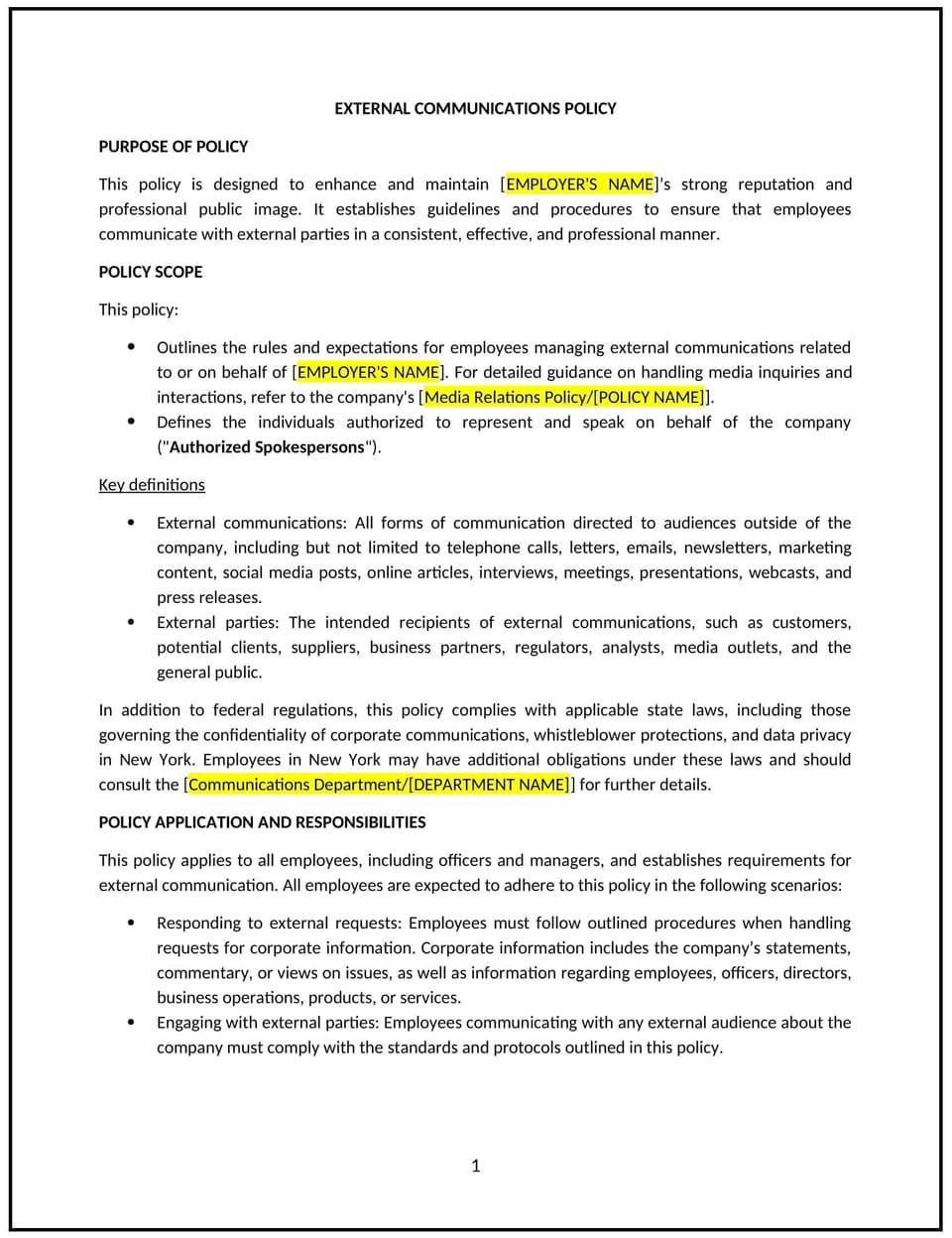External communications policy (New York): Free template

External communications policy (New York): Free template
This external communications policy is designed to help New York businesses establish clear guidelines for managing communications with external stakeholders, including customers, vendors, media, and the public. Whether businesses are responding to inquiries, sharing company updates, or managing a crisis, this template ensures consistency, professionalism, and alignment with organizational goals.
By using this template, businesses can protect their reputation, streamline communication processes, and minimize risks associated with unauthorized or inconsistent messaging.
How to use this external communications policy (New York)
- Define communication channels: Specify approved channels for external communications, such as email, social media, press releases, or official statements.
- Assign responsibilities: Clearly outline which employees or departments are authorized to communicate on behalf of the business, such as a communications team, PR agency, or designated spokesperson.
- Set approval procedures: Establish a review and approval process for external messages to ensure accuracy and alignment with business objectives.
- Include guidelines for content: Provide standards for crafting professional, clear, and consistent messaging that aligns with the company’s tone and values.
- Address crisis communication: Include a plan for managing external communication during emergencies or crises, including escalation procedures and designated points of contact.
Benefits of using an external communications policy (New York)
This policy offers several benefits for New York businesses:
- Protects the business’s reputation: Consistent and professional communication helps build trust with external stakeholders and mitigates risks of misinformation.
- Improves efficiency: A structured approach to external communications streamlines processes and reduces delays in responding to inquiries.
- Reduces risks: By limiting communication to authorized personnel, businesses can avoid the release of unauthorized or inaccurate information.
- Enhances brand consistency: Clear guidelines ensure that all external messaging reflects the company’s values, tone, and objectives.
- Supports crisis management: A proactive approach to crisis communication minimizes potential damage and ensures timely, effective responses.
Tips for using this external communications policy (New York)
- Regularly train employees: Ensure employees understand the policy, including who is authorized to communicate externally and the approval process for messages.
- Monitor communication channels: Actively monitor social media, email, and other communication platforms to address issues promptly and maintain consistency.
- Keep messaging templates ready: Prepare standardized templates for common communications, such as media inquiries or customer updates, to save time and ensure accuracy.
- Test crisis communication plans: Conduct simulations or drills to ensure the crisis communication plan is effective and that employees understand their roles.
- Review the policy regularly: Update the policy to reflect changes in communication technology, business operations, or legal requirements in New York.
Q: Why is an external communications policy important for businesses?
A: This policy helps businesses maintain consistent messaging, protect their reputation, and ensure that external communications align with company values and objectives.
Q: Who should be authorized to communicate externally?
A: Authorization should be limited to specific roles, such as communications or PR teams, senior leadership, or designated spokespersons.
Q: How can businesses manage unauthorized communications?
A: Businesses should educate employees on the policy, monitor communication channels, and take corrective action when unauthorized communications are identified.
Q: What should a crisis communication plan include?
A: A crisis communication plan should outline escalation procedures, designated points of contact, and steps for crafting and distributing messages during emergencies.
Q: How often should the policy be reviewed?
A: The policy should be reviewed annually or whenever there are significant changes to communication practices, technologies, or New York state regulations.
This article contains general legal information and does not contain legal advice. Cobrief is not a law firm or a substitute for an attorney or law firm. The law is complex and changes often. For legal advice, please ask a lawyer.


